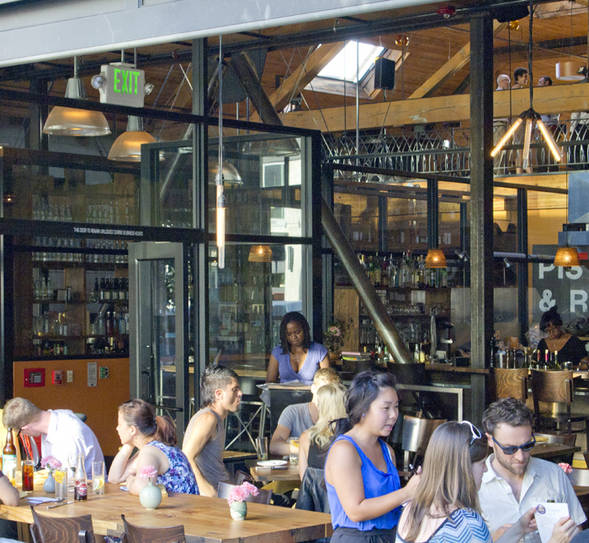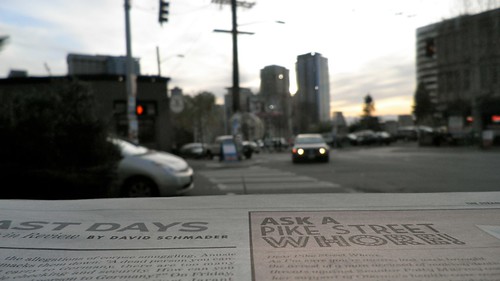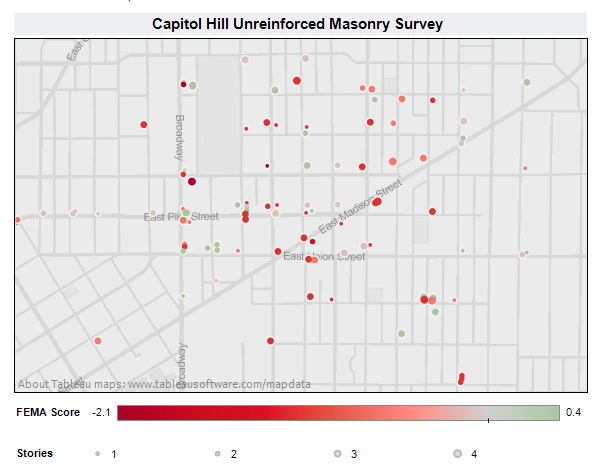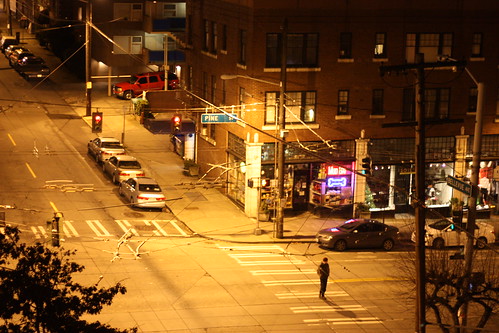The story of changes coming for E Pine between Melrose and Bellevue is just beginning. Our full report on the plans to develop a mixed-use building at the site is here. The post has been viewed some 25,000 times since we first broke the news Friday morning, has been shared more than 5,000 times on Facebook and generated more than 200 comments on CHS. It is a story with the potential to — once more — set the tone for Capitol Hill’s future. It is also a story about some people’s favorite coffee shop, record and book store, vintage and fashion shops, pet supply store and, for a few, their apartment homes. It’s about density and preservation. It’s about change. Below are the latest updates on the development plans, reports and commentary on the situation from other sites and more details of what comes next.
- Call us? CHS heard back from the prime movers in this deal — Madison Development Group partners Tom Lee and Jim Gallaugher. A spokesperson tells CHS that it is still early in the process for Hewitt Architects but the overall plan for the development is adaptive reuse and preservation of the two main buildings’ facades. She also emphasized that the purchase has not yet closed, a typical situation for large land and development deals with lengthy land use and design processes to work through.
The spokeperson tells CHS that developers face a difficult tenant mix and wanted to give existing business owners a lengthy opportunity to work out solutions and, for some, to make other plans before construction is slated to begin in summer 2013.
There appears to be little or no possibility of the developers retrofitting the property as the spokesperson said the buildings need significant investment. The spokesperson said the owners looked at the situation and were either going to make seismic upgrades or sell their holdings./p>
The MDG spokesperson said the final price for the six parcels between Bellevue and Melrose has not been finalized with the land’s long-time owners, the Lucurell family. Editor’s note: We’ve updated the information in this section per a request from the spokesperson to clarify information provided “on the record” to CHS.
We also asked about the possibility of a community meeting to discuss the project. The spokesperson said it’s on the list of possibilities as MDG swings its community outreach effort into action. She also invited questions from CHS. For now, those will need to come through us. Let us know in comments what else we should be asking.
- ‘Adaptive reuse plus density’: The Daily Journal of Commerce also spoke with the MDG rep who told the paper “This is an adaptive reuse plus density, not a tear down.” She also said more details would be available in May “when MDG plans a formal announcement.” DJC says the developers also recently acquired a large property in foreclosure in West Seattle.
- Plus parking: It is, however, adaptive reuse with big plans for a seven-story building and underground parking. From the DPD project filing:
Construct new 7-story mixed use building apartment and commercial with 2 floors of underground parking in conjunction with identified character structures in the Pike/Pine Overlay District.
“One big question is WHY PARKING at all?” a representative from a neighborhood community group asked in an email to CHS. “The developers probably feel they can’t make it work without parking. Underground parking necessitates tearing down the buildings. What if there were no parking, and the project was a mix of rehab and new construction?”
The MDG spokesperson said she would ask Lee and Gallaugher about the parking and get back to us.
By the way — you’ll note a few unnamed sources in this report update. When we can, we prefer to have sources on the record but this situation is so early and still at a sensitive enough stage that we’re open to getting more information in the report without (hopefully) burning bridges between the developer and the community groups looking to work with them.
- Zero room: The Seattle Land Use Code blog took CHS to task for leaving “absolutely zero room to consider the possibility that the acquisition might lead to some good.” —
In talking with the baristas (who know me and what I drink without me asking) I found out they have known this was coming. The buildings need to be retrofit to make them safer for, you guessed it, people. In our chat at the register we agreed the point is to make whatever happens good, better than other things we don’t like. But the buildings are going away.
While we disagree with the “zero room” part, a retrofit may well, indeed, be in order for the buildings being acquired. That’s something we plan to ask the Madison Development Group about. In our first report, CHS talked with a person with direct knowledge of MDG’s plans who said early discussions were not about retrofits or preservation:
A person with knowledge of the deal said the developer acquired the parcels at Pine and Melrose with an eye toward leveling all of the buildings and starting fresh but has had second thoughts after witnessing the backlash against the lack of preservation in this development at 10th and Union.
- A retrofit neighborhood: CHS wrote about the architecture of retrofit Pike/Pine buildings here last September. It’s a fantastic essay by John Feit highlighting how many of the buildings you walk by and hang out in every day have been overhauled to stand up to big quakes.
 The Piston Ring building’s inner braces (Image: John Feit with permission to CHS)
The Piston Ring building’s inner braces (Image: John Feit with permission to CHS)
Many of Capitol Hill’s buildings were built prior to the time when seismic bracing was required by code. Such buildings, if they have neither gone under a significant renovation nor a change in use (from, say, an automotive showroom to a restaurant, common here on the Hill), have not been required to incorporate bracing. As seismic bracing is an expensive proposition, building bracing without a mandate is uncommon which is why many of our older buildings simply do without.
That being said, the observant Hill resident will notice many older buildings do indeed have bracing, a signifier of a change in a building’s original use, its expansion, or significant renovation. While the types of forces to be resisted are the same, the magnitude and resolution varies from building to building. This is largely due to the space available for bracing and the size and configuration of the building, leading to a variety of bracing solutions, many of which are visible on Capitol Hill. As each new earthquake provides a test of the current seismic designs, engineers continually refine their approaches, adding yet another layer of variety and richness to this seemingly utilitarian but lifesaving task.
- URM: CHS reported on the prevalence of Pike/Pine unreinforced masonry in 2011 and included an ‘URM’ map of the neighborhood complete with FEMA risk scores (low is bad!) to mark the tenth anniversary of the massive Nisqually quake. Bauhaus’s Melrose Building wasn’t included in the survey data collected by the City of Seattle but Mud Bay’s 1535 Bellevue Ave was — it rates a “0,” by the way, placing it well above some of the riskiest old buildings in the area including the Volunteer Park Water Tower’s freaky -1.5.
- The next Bauhaus? By the way, if you want to start thinking about the next building to “save,” one interesting exercise is to sort the neighborhood properties included in past surveys by FEMA score. You’ll find that many if not most of the highest risk buildings have already been demolished or overhauled over the years since the datasets were collected. One building that has a relatively high risk score but does not appear to have been retrofitted since the study that could be the next development target? 1319 E Madison’s Callahan Auto building.
- Getting involved: One of those groups is PPUNC — Pike/Pine Urban Neighborhood Council. They popped up in comments on the original CHS post with information on joining their effort to shape the Melrose & Pine project. You can learn more about the group here.
A (slightly xenophobic) Maintain Capitol Hill group has also emerged on Facebook to rally around the issue. “Eastsiders should be barred from attempting to re-develop our neighborhood! We didn’t ask for this. Stop the relocation and cementing over of our community,” the group’s description reads.
We’ve also heard from a few other groups planning protests or actions. Babylonia Aivaz, the woman who “gay married” the got-demolished-anyway warehouse at 10th and Union, tells CHS she’s planning a letter writing party at Bauhaus later this week.
- What can be done? Community group representatives and an activist we contacted say there is some potential in pursuing landmark status for the buildings involved in the project. As we’ve reported in the past, the Seattle landmark process is used by developers to further their control of old buildings as frequently as it is used to “save” the city’s historical architecture. You can review the roster for existing Capitol Hill and First Hill/Central District landmarks to get an idea of the types of buildings where the designation has been successful in our area. Note you won’t find too many unreinforced masonry structures on the list. We’re also trying to learn more about why this effort to designate downtown buildings didn’t extend up the Hill. Meanwhile, the restrictions on landmarked buildings are documented here. Take a note that demolition of a landmarked building can still be approved by the board. In the meantime, no word on any legal activity like the situation that came up on E Pine in 2008 that — along with the downturn in the global economy, of course — lead to the People’s Parking Lot.
The representative for the developers did not know if MDG was planning to apply for landmark status for any of the buildings it is acquiring but would get back to us with more information shortly.
- Two points: In talking with people from community groups the business community in the neighborhood. Issues around the development plans at Melrose and Pine seem to boil down to two bullet points:
1) These buildings — FEMA not withstanding — are functional and lively. Why not come up with a plan that preserves them intact?
2) Why haven’t the developers done more to consult with more organizations and groups in the neighborhood? This could be a matter of logistics but we know that there were consultations with some other property owners in the area including Hunters Capital who just announced its purchase of the Stanley Automotive Building at E Pine and Bellevue.
- The Mayor comes to the neighborhood He might be, you know, interested:
Pike & Boren neighborhood town hall with Mayor McGinn
Tuesday, 4/24, 5 – 6pm
Location: Terra Plata restaurant, 1501 Melrose Ave, Seattle, WA 98122 - B&O was not a landmark: The Bauhaus situation has some mirroring in the development process that will eventually displace B&O from East Olive Way. You might recall that an effort to declare the property a landmark failed in January 2010 (an attempt to block the project because of its damage to views from the Hill also failed, by the way). The process to apply for the landmark status is lengthy and requires a significant amount of research so it’s most typically undertaken by groups and organizations. Shall we end on an optimistic note? Here’s a CHS report about how a community group organized the nomination to designate the Volunteer Park Conservatory a landmark — and won.






This Weds the City Council will be meeting about the new Regulatory Reform proposals courtesy of our incompetent Mayor and his developer henchmen. A vote could happen at this meeting. If it passes you can kiss our neighborhood good bye. Bellevue Square here we come!
I would urge anyone concerned about historic preservation, parking issues and having a peaceful quality of life in our neighborhoods to write the Council and his highness demanding that they REJECT the biggest developer give away in Seattle Land Use history!
OR we could all show up at the meeting (Weds 11th April at 9:30 am) there will be a public comment period before the meeting. (Beware that the Mayor’s “suits” will be there defending this idiotic and unnecessary idea.)
Thanks for pushing. Hopefully it WILL change things!!
I know this is going to sound a little cliche, but after taking a deep breath, I think we all need to really commit to trying to find a joint solution that can work for the neighborhood and MDG. Unfortunately the blunt reality is that current regulations favor the developer. We may not agree with these regulations but thats what this project is working under and no movement in law will be quick enough to change that.
I think in previous cases, such as B&O and 500 Pine, things quickly devolved into an us vs. them battle, and that simply will never work. If the developer feels the community won’t budge from an entirely anti-development stance, then for them, outreach and engagement just isn’t worth it. They NEED to make their return back and they will unquestionably be willing to spend millions to ensure that. That’s business.
We need to start from an open dialogue position and point out to MDG that working with the community can add value to this project if they are willing to think outside the box. We have great local resources (Hunters Capital,Preservation Green Lab, PPUNC, CHH) that can provide real hard data on the costs and benefits of rehabs and preservation. The community can help push for innovative cost saving techniques or help secure grants for public benefits in the project.
That isn’t to say we shouldn’t carry the stick as well. We certainly have legal challenges and appeals processes we can push for that can be costly for MDG. But let’s definitely not start there.
Capitol Hill is one of America’s (yeah I said it) greatest urban neighborhoods. Some of that come from the buildings, but most of it comes from the people. Let’s use our unparalleled social capital and help turn this seeming threat into a new asset.
for keep us so well informed. Knowledge is power right ;)
I’m having trouble making any connection with the proposed “Regulatory Reforms” and this troubling project. Maybe the reforms will improve developer flexibility and make them fiscally able to preserve old buildings like these, including not forcing them to level buildings to meet minimum parking requirements. Be careful where and how you wield your grief…
i’d be curious to hear what the designers who are reading this think of the term “adaptive reuse” being applied to just facades. i’m no expert, but when i hear that phrase, i think of old facilities being converted to new uses, rather than just salvaging the exterior and tacking it onto a shitty new box. the flagship REI in Denver is in an old power plant, for example; the silly overpriced condos at 16th and Denny in that old church seem like they would count as adaptive reuse too…
and thumbs up to a letter-writing party, babylonia!
With inaccurate and hyperbolic comments like Ivana’s above being the norm, why would any developer ever opt to “consult with more organizations and groups in the neighborhood”?
The comment section from Friday’s post shows that the “neighborhood” has a fundamental misunderstanding of the land use code and the development process coupled with a propensity to rush to judgment.
Why seek advise from people who have zero interest in approaching the issue with an open mind?
Adaptive reuse, or ‘façadism’ examples include the Cristalia conominiums on 2nd Ave. in Belltown.
We need to be working toward win-win solutions that save more than facades. City policy-makers can’t afford to stand on the sidelines here — Pike-Pine is an incredibly powerful engine for local economic development and that’s because of the distinctive character of its buildings and the businesses in them. If the conservation overlay isn’t working, this is the time to fix it. There are alot of moving parts — the conservation overlay was intended to allow for MORE density and MORE profit than the regular zoning code, but much of this is being undermined by the developers’ perceived demand for underground parking. It may be time to set parking maximums for in-city neighborhoods, not just do away with parking minimums. If all developers were on an even playing field with respect to NOT having to provide parking, they would feel far less compelled to tear out the guts of these buildings in order to dig a big hole. They would save considerable amounts of money — some of which could be targeted to neighborhood transit and carshare programs. And if new construction developers can’t figure out how to seismically retrofit the URM buildings at a profit, then these should be sold off to those who have that skill set. Sellers are not being smart about trying to match their properties with appropriate buyers who might actually pay MORE for the old buildings than the land under them. Especially if there was a WORKING transfer-of-density program that was actually banked and supported by the City.
With all due respects Mr. Architect I am pretty up on the zoning as my partner is an architect as well.
My main issue about the Reform proposals is that it appears to be a 100 percent developer/designer driven thing. The communities affected have been left out of the process. The Roundtable assembled by our Mayor reads like a who’s who in the development world. Anyone I talk to that LIVES in the neighborhood has concerns about some if not all of the proposed changes.
It’s almost as if properties are being snapped up because developers have been PROMISED sweeping changes to the code. Public comment is nothing but a formality and perhaps it is already a done deal??
I think it’s BS.
First, I am not weighing in on whether or not its appropriate for this project.
A facadectomy is not the same thing as adaptive reuse. I would not consider projects like the Cristalia an adaptive reuse, where the only vestige of the original building is the thickness of it’s facade and its outward appearance. Adaptive reuse refers to some form of rehabilitation and re-purposing of the original structure, not transplanting a facade onto an entirely new structure. To liken a facadectomy to adaptive reuse is inaccurate. To do so as a design professional is disingenuous and seemingly manipulative.
I’m normally in favor of simply eliminating parking requirements rather than instituting maximums, but this case is causing me to rethink that policy. The problem is many developers are either accustomed to building in areas that need lots of parking, or the banks and other lenders require parking out of some belief that the project will be unsuccessful otherwise. Anyone who knows this area knows that very very little parking is necessary. Within a 15-minute walking distance residents could access most of downtown, south lake union, capitol hill, and first hill. Plus there are lots of amenities right in the immediate area. Add in multiple bus lines and close access to streetcar and light rail, plus decent bicycle access, and you have a perfect site for near-zero parking. If the cost and logistics of building two levels of underground parking is what is causing the need to level the buildings rather than rehab and add onto them, then the parking is what the community should focus on.
We received an email response from a representative of the Historic Seattle non-profit that says they will definitely be advocating for the saving of the buildings. Yeah for progress! Lets all keep rallying the community toward this goal! They need our support as much as we need there help!
When I was initially consulted about the Bauhaus block project (I work for a semi-private firm that manages public expectations—we operate more or less word-of-mouth along the west coast), the developers professed that they wished to keep the existing facade(s) and would do anything to preserve these facades because they had [correctly] anticipated the great public appeal of preservation—to which I agreed and also add that for some reason citizens always see this as “green” when usually the employment of “preservation” results in the people warranting full license (just in totally ignoring anything past the facade treatment) to use the cheapest and least “green” materials and methods possible to compensate for the cost of the “preservation”.
The developers and I decided that in no way possible would the community accept the first design bid on this project. Seattlites (and the same goes for most communities on the west coast) feel as if great progress is achieved so long as any first proposition is rejected. This is more or less common developer-employed psychology when regarding “difficult” developments. Under my guidance, the implied threat of complete tear-down was established and went into practice under various arrangements.
In a nutshell, through displaying the pendulum (rather, wrecking ball) swung so far in the direction of the developers/greed/cultural annihilation e.g., everyone is quickly assimilated aboard when the original plan (to preserve the facades) is presented—There was never any question as to whether these facades were to stay or go. To imply that concessions were suddenly made as a reaction to blog posts and other agents of dissemination is an easy trick to inflict upon the folks we’re interested in manipulating to our will.
Look. Facade preservation is the hot topic right now. Even at Bauhaus. Everyone is on board. We won, you lost. 21st century psychological socioeconomic warfare.
and I’m pretty sure that pretty soon my career in manipulating public mindset will going to go the way of the bauhaus block. I just can’t do it anymore though. It’s too sick, and EVERYONE is on board. Everyone. Where are you getting your information? Think about it.
I missed today’s meeting but I’ll make this short and sweet. These businesses are important to the community. I’m being selfish, and I’ve been a customer of Bauhaus, Le Frock, and MudBay for 15 years(and I no longer live anywhere nearby the block), but please. Keep and support the character and the businesses. And don’t tear down Bauhaus.
Interesting post. Especially the “we won you lost” part. A variation on “you can’t fight progress” or “can’t fight city hall” from a century ago.
The issue isn’t progress though, the issue is whether empty facade equals saving the building. Most reasonable people would say it does not. But then most reasonable people aren’t eastside developers … or their wanna-be psy-ops shills.